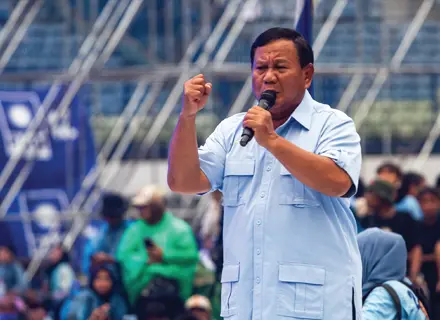In March 2024, Indonesia’s election commission confirmed Defence Minister Prabowo Subianto as the Southeast Asian nation’s next president. Prabowo won the February 14 contest with more than 58% of the nationwide vote. Immediately after his election win, Prabowo pledged to govern for all Indonesians, apart from repeating his earlier pledge of continuing the economic policies of President Joko “Jokowi” Widodo, who during his decade in power, focused mostly on overhauling Indonesia’s infrastructure and promoting foreign investment.
“We will use the strong foundation he has built, especially in the economic sector, to work faster, harder, to bring results as quickly as possible to the Indonesian people,” Prabowo said.
In this article, we will explore the significance of the outcome for the Indonesian economy.
The ground reality
Joko “Jokowi” Widodo came to office in 2014 by pitching a promise of raising the Southeast Asian country’s growth rate to 7%. Prabowo has taken the game higher by suggesting that a double-digit growth was possible.
However, the Q4 2023 data shows that Indonesia’s GDP growth settled at 5.0%. The economy grew 0.45% compared to the previous quarter, and economic activity picked up ahead of the election.
Household spending (up by 4.5%) supported the growth. Government outlays posted growth but were more modest, up roughly 2.8%. The economy also got a boost from fixed capital formation, which expanded 5.0%, thereby managing to post decent growth despite seeing borrowing costs at elevated levels.
While Indonesia’s growth remains resilient, supported by declining inflation and a stable currency, the World Bank states that the nation’s GDP growth will ease slightly to an average of 4.9% over 2024-2026 from 5% in 2023 as the commodity boom loses steam. Private consumption will be the primary growth driver, while business investment and public spending will also pick up due to reforms and new government projects.
However, the overall economic outlook still possesses downside risks, mostly due to external factors like higher-for-longer interest rates in major economies, which, apart from weighing on global demand, will increase borrowing costs and make it harder to borrow on world markets. Add the geopolitical uncertainties, which may disrupt supply chains.
The World Bank has some advice for the Southeast Asian country: speed up growth and strengthen resilience while transitioning into a low-carbon and climate-resilient economy that will eventually reduce poverty.
Despite being a resilient economy, achieving the 7% target looks like a pretty tough one for Indonesia as of now. The last time it achieved the milestone was way back in 1996, just before the Asian Financial Crisis. Since the Southeast Asian country transitioned to democracy in 1998, promises of higher growth have remained as empty rhetoric than the policies that could have supported the plan.
Looking back at the Jokowi rule
Widodo wasn’t able to complete his “7% growth” prophecy. However, he has achievements to flaunt. A decade ago, Indonesia used to be one of the “Fragile Five”, a group of emerging-market economies vulnerable to high interest rates abroad and a strong dollar. As of 2024, its current account is roughly balanced and its external debts are modest.
Jokowi’s omnibus bill, which cuts restrictions on foreign investment and simplifies licensing, finally became law in 2023. Also, Indonesia’s infrastructure has improved over the past decade, highlighted by the construction of thousands of kilometres of roads.
Jokowi’s other milestone is Indonesia’s nickel-focused industrial policy. The metal is used in electric vehicle (EV) batteries, and Indonesia has the world’s largest deposits. Indonesia, by banning the export of its raw ore, is now forcing companies to process and manufacture in Indonesia. BYD, Ford and Hyundai are now investing in the Southeast Asian nation.
Exports of ferronickel, a processed form of the metal, rose from $83 million in 2014 to $5.8 billion in 2022. However, as per Cullen Hendrix of the Peterson Institute for International Economics, lithium-iron phosphate batteries, which contain no nickel, are becoming more popular. Sodium-ion batteries, which need neither nickel nor lithium, could surpass both types. In 2024, JAC Motors, a Chinese carmaker, delivered the first lot of commercial vehicles powered by sodium-ion batteries to customers.
Despite reforms introduced by the omnibus law, rules requiring imports to be screened at particular entry points have remained at a 22% tariff, and as per the World Bank, the ratio is more than twice the South-East Asian average.
Compare Indonesia with its neighbours Malaysia, Thailand and Vietnam and there is a stark difference. The three countries place fewer restrictions on outside investors and are becoming obvious destinations for firms looking for alternatives to Chinese manufacturing. Indonesia is losing out big time here, as its exports of electronics are not just lower than any other large economy in Southeast Asia, but the sector’s overall growth ratio in the country has slowed down too.
However, not everything is bleak. Since 2014, the Indonesian economy has grown by an average of 4.2% every year. Take out the pandemic years of 2020 and 2021 that figure goes up to 5.1%. Economic activity has not remained entirely dependent on commodity exports, with growth being increasingly driven by a combination of consumption and investment.
According to World Bank data, net foreign direct investment averaged USD 15.5 billion a year from 2014 to 2022, and portfolio investment averaged USD 12.6 billion a year. Investment has come from a variety of sources and in a variety of forms. Domestic capital markets have flourished, especially the stock exchange, whose market cap has grown tremendously over the last 10 years, with hundreds of new companies having gone public.
On the infrastructure front, the count of toll roads, airports, power plants, and dams has gone up in 10 years. At the same time, fiscal reforms drove tax revenue up. Despite increased spending, Indonesia’s fiscal health is quite good. One can argue that the Jokowi era also saw wasteful public works projects, widespread corruption, and the prioritisation of economic growth over the interests of local communities and the environment. However, a 5% annual growth anchored by investment and consumption, combined with big spending on infrastructure and social welfare and financed by sound fiscal policies makes the outgoing President’s rule a fruitful one.
Indonesia has a goal of becoming a high-income developed country by 2045. To fulfil that, the nation needs a national programme capable of effectively harnessing Indonesia’s human capital and population characteristics. Widodo’s “Kartu Prakerja” programme has become a good example for the future Indonesian administration to advance the nation’s economy by harnessing human capital.
The programme, which aims to enhance the competence, productivity, competitiveness and entrepreneurial development of Indonesia’s workforce, has been made available for Indonesian citizens over 18 years who are not enrolled in formal education and do not engage with other welfare programmes.
The Kartu Prakerja programme, a conditional cash transfer scheme, started in 2020. Under it, participants get vouchers to purchase training courses and once they complete the training, they receive a cash incentive. In the pandemic-disrupted 2020, the initiative reached over 5 million. A further 17.5 million recipients were reached in the next couple of years through online training, with the beneficiaries getting digital wallet incentives through fintech companies and banks.
Reimagining things under Prabowo
What the Southeast Asian country needs is a series of reforms that will allow investors to deliver the jobs boom. These reforms can be as simple as regulatory changes like creating a truly level playing field between state-owned and private enterprises or allowing easier immigration avenues for skilled foreign labour. In short, reforms that will make the Indonesian economy a competitive one in a globalised world order. Also, Prabowo needs to ensure job creation, poverty reduction and price stability.
“Prabowo’s economic technocrats need to convince him, in the context of a still-underdeveloped tax base and limited domestic savings available to underwrite private and public investment, that alongside deepening Indonesia’s own capital markets, there is no alternative to inviting a bigger role for foreign investment in the economy if Indonesians’ expectations for growth, expanded public services and better employment prospects are to be met,” EastAsiaForum noted.
The former general has an ambitious plan to raise the tax-to-GDP ratio from 10% to 16% and become a food-exporting nation in the next four years. His 8% growth target is higher than the World Bank’s January 2024 forecast, which predicted Southeast Asia’s biggest economy to grow only 4.9% this year and next.
Bhima Yudhistira, director at the Jakarta-based Centre of Economic and Law Studies (Celios), while interacting with the South China Morning Post, called Prabowo’s 8% growth forecast a “delusional and unfounded” target that was reminiscent of Widodo’s promise of a 7% annual growth rate during his first presidential campaign a decade ago.
Prabowo intends to raise the budget deficit cap, currently set by law at 3% of Indonesian GDP, as well as increase the government debt-to-GDP ratio from the current level of 38.11%. He has pledged to uphold Widodo’s economic policies while urging the nation to adopt the best economic practices from major Asian powers such as China and India in order to progress. Additionally, he has promised to enhance the private sector’s contribution and promote efficiency in state-owned enterprises.
Prabowo has also sought advice from experts on potential new sources of tax revenue. As per the OECD, Indonesia’s current tax ratio of around 10% is lower than the Asia-Pacific average (19.8% in 2021). Bhima thinks that in case Prabowo raises taxes for the country’s 52 million middle class, the move will affect Indonesia’s purchasing power and household consumption.
Bhima credited outgoing Finance Minister Sri Mulyani Indrawati behind Indonesia’s sound fiscal discipline. However, it’s unclear that Sri will join Prabowo’s new cabinet as her relationship with the government soared since Widodo asked the veteran economist to allocate more spending to social assistance programmes ahead of the election.
In December 2023, Prabowo revealed that his programmes to modernise Indonesia’s ageing military were hindered by a lack of funding. This, as per the analysts, may have also hurt his ties with Sri.
“The future minister of finance must act as a brake on Prabowo’s populist programmes. If you can’t apply the brakes, there will be fiscal pressure that will be felt by all economic indicators, and capital outflow will occur,” Bhima told the South China Morning Post.

